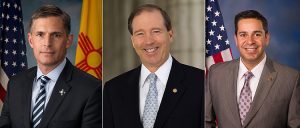The public will get a chance to comment and learn more about Los Alamos National Laboratory’s plans to release radioactive vapors into the atmosphere from several barrels of tritium-tainted waste.
BY: SCOTT WYLAND | santafenewmexican.com
The federal agency that oversees the lab scheduled the meeting for Oct. 20 after three New Mexico delegates — U.S. Sens. Tom Udall and Martin Heinrich and U.S. Rep. Ben Ray Luján — wrote a letter calling for more transparency and public participation.
An open forum on the release of vapors from Cold War waste is especially important for Pueblo people and others who live near the site, the delegates said in the letter to the National Nuclear Security Administration.
“We strongly believe that protecting public health and safety must always be the highest priority at Los Alamos,” they wrote in the Oct. 1 letter. “Safety is particularly important when there is a possibility of a release to the environment involving radioactive or hazardous materials.”
The agency has said ventilating the containers is necessary to relieve built-up radioactive hydrogen in their headspace, so they can be safely handled and shipped to a commercial storage site.
The agency has set no date for the release, though a representative said it will happen before winter.
The Los Alamos lab had originally planned to ventilate the barrels in April, but it postponed the project after the COVID-19 crisis led to some of the necessary personnel working from home.
Tritium is a radioactive hydrogen isotope and is found, both in natural and human-made forms, in water, soil and the atmosphere. It is generally only harmful when ingested in high doses in food and water, and it can increase the risk of cancer in some people, according to the Health Physics Society.
However, some medical research groups, such as the National Academy of Sciences, contend any amount of radiation exposure can risk damaging tissues, cells and DNA, potentially causing genetic mutations, birth defects and cancer.
Given the potential risks, federal officials should explain in a public meeting why ventilating the barrels is the best method for dealing with the waste, how well the systems that filter the radioactive vapors will work and how the process will be monitored, the delegates’ letter said.
Officials also should discuss the maximum amounts of tritium that will be released and the specific regulatory roles of the Environmental Protection Agency, the state Environment Department and the Defense Nuclear Facilities Safety Board, the letter said.
The tritium in the four waste drums adds up to roughly 114,000 curies of radiation. A curie is a unit of radioactivity equal to what a gram of radium emits.
The lab’s EPA application states high-efficiency particulate air filters and other equipment would significantly reduce the tritium if it is released, though it couldn’t say by how much.
Lab officials have said they would release no more than 8 millirems, staying within the EPA’s yearly limit of 10 millirems for the site. A millirem measures radiation exposure.
Activists and community members sent a letter to state Environment Secretary James Kenney last month, asking that the vapor release be suspended and other alternatives explored, such as recycling the tritium or burying the containers at the lab’s Area G disposal site with other legacy waste.
Jay Coghlan, executive director of Nuclear Watch New Mexico, gave Udall, Heinrich and Luján some credit for pressing federal agencies to hold a public meeting, though he thinks they were responding to their constituents.
The real credit belongs to the concerned citizens, including Pueblo people, who have spoken out against the planned tritium release, Coghlan said.
“This meeting will hopefully begin to bring some accountability to an agency that always puts unnecessary and environmentally damaging nuclear weapons production above public health and safety,” Coghlan said.

